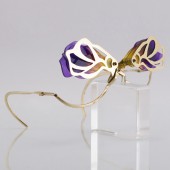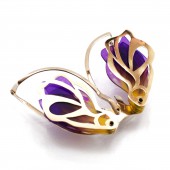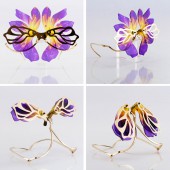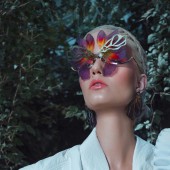
| THE AWARD |
| CATEGORIES |
| REGISTRATION |
| SUBMIT YOUR WORK |
| ENTRY INSTRUCTIONS |
| TERMS & CONDITIONS |
| PUBLICATIONS |
| DATES & FEES |
| METHODOLOGY |
| CONTACT |
| WINNERS |
| PRESS ROOM |
| GET INVOLVED |
| DESIGN PRIZE |
| DESIGN STORE |
| THE AWARD | JURY | CATEGORIES | REGISTRATION | PRESS | WINNERS | PUBLICATIONS | ENTRY INSTRUCTIONS |
Blooming Folding Eyewear by Sonja Iglic |
Home > Winners > Design #57916 >Interview |
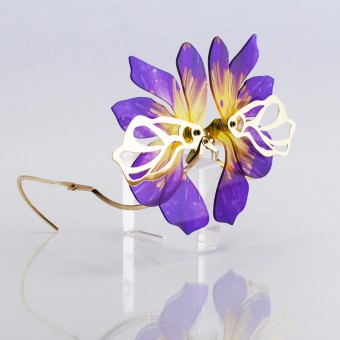 |
|
FS: What is the main principle, idea and inspiration behind your design?
SI: My initial inspiration comes from nature‘s growth and it‘s metamorphosis into something new each day. In that sense, blossomed flowers are used as a symbol of change and development of all beings. The idea was to create multipurpose items, that can adapt to the specific needs of the wearer and their personal emotional changes throughout the day.
FS: What has been your main focus in designing this work? Especially what did you want to achieve?
SI: I wanted to achieve a feeling of lightness and flow. As stressful lives are becoming a normality nowadays, I wanted to achieve a greater sense of awareness of the feelings that emerge every day and to bring in a calmer reaction to the surface. The most important thing that I wanted to point out is that our minds should become more calm. The petals were supposed to move easily and gracefully just like the blooming of a real flower would look like. Looking at the time-lapse videos of flowers blossoming has made me want to achieve that exact grace throughout this whole collection.
FS: What are your future plans for this award winning design?
SI: I don‘t have any specific plans, but I‘d love to expand my production and incorporate more models.
FS: How long did it take you to design this particular concept?
SI: Designing the eyewear alongside the whole accompanying collection of jewelry took me about 3 months. But the whole idea was in my head for quite some time, so I'm not sure how long it really took me to make all this a reality.
FS: Why did you design this particular concept? Was this design commissioned or did you decide to pursuit an inspiration?
SI: I just really wished to create this concept that was on my mind for a long time. I did not have any special plans related to this work. Instead, I envisioned the project just like a sculpture that I needed to make. Just a piece of art with no other intentions in mind.
FS: Is your design being produced or used by another company, or do you plan to sell or lease the production rights or do you intent to produce your work yourself?
SI: I haven‘t decided on that yet. For now, I‘m still enjoying the process of doing it myself. I really wanted to give that bespoke experience to the customers, as well as the feeling of luxury with the possibility of adapting the eyewear to each of the wearer‘s head. I‘m always very open to new opportunities and proposals, but I‘d love to keep a luxury approach to this particular design, that‘s for sure.
FS: What made you design this particular type of work?
SI: I had this picture in my head in which the raw natural beauty of a female‘s head is surrounded by beautiful flowers that flourish. As this repeated in my head so many times, it really got me thinking about how it could be made and what kind of accessory could it be. This thinking process eventually led me to a type of folding, changing, blooming eyewear. The rest was really just figuring out how to make it all work. After the eyewear was made, I went on and made a whole collection of jewelry with the same approach. But still, these headpieces are the central piece of the whole concept.
FS: Where there any other designs and/or designers that helped the influence the design of your work?
SI: I don‘t think there was a specific person or design. I haven‘t really seen anything like this, but I believe that everything that is designed today is somehow connected to something we‘ve seen before. That‘s anyway, how the inspiration works. One can never tell what led him/her to design something, it‘s really a collection of experiences mixed with the designers environment and feelings.
FS: Who is the target customer for his design?
SI: Anyone who‘s in love with fashion and is not afraid to show it. There is no age limitation nor style. It can be worn by a most minimalist person as a statement piece as well as the most crazy over the top Fashionista.
FS: What sets this design apart from other similar or resembling concepts?
SI: I don‘t think I‘ve seen anything like this particular concept, not just in the sense of foldable frames like these, but also in the idea of movable parts especially lenses.
FS: How did you come up with the name for this design? What does it mean?
SI: With the name Blooming I really wanted to emphasize the movement of the eyewear and the fact that they could figuratively bloom. So the name is quite literal, but also, it should leave the sense of lightness, romance, and new beginnings.
FS: Which design tools did you use when you were working on this project?
SI: This project required a really big research on the eyewear frames as well as a long thinking process behind their functionality. It was really important for me to make it user friendly and make it really easy to handle. Yet, I wanted to keep some of the complexity like for ex. 10 lenses that could be moved to different positions. I had a lot of work on the computer, making all the petals for the whole collection, making patterns for prints, cutting the plexiglass to shapes and so on. The frames and metal petals, however, were made entirely by hand, so I also used everything in the metalsmith workshop that was required for creating these parts by hand.
FS: What is the most unique aspect of your design?
SI: Definitely the possibility to change the appearance in a second. It goes from a minimal simple design with a bit of secession to a full statement piece in no time. How the petals are interconnected and how they overlap will determine the end look. In my opinion, that is the beauty of this product.
FS: Who did you collaborate with for this design? Did you work with people with technical / specialized skills?
SI: Yes, at some point I needed to double check the functionality of the eyewear and especially the ergonomic part of the design with my partner, as he is a professional industrial designer. He was really helpful, because he already knew my project and therefore really understood what I wanted to achieve. Also, after making the first prototype, the reactions of close people who were able to try them out, gave me a lot of insights for improvement. It‘s always a great idea to consult anyone who is specialized or a possible user, as they can give the designer a different perspective that they haven‘t thought of before.
FS: What is the role of technology in this particular design?
SI: I‘ve used modern technology as much as I was able to. But my idea is going beyond what is available, so hopefully this will inspire experts to find the way to create lenses that could have full spectrum of colors. Right now, it is print on plexiglass, but I‘d love it to be real usable lenses with prints like the ones I‘ve used.
FS: Is your design influenced by data or analytical research in any way? What kind of research did you conduct for making this design?
SI: This project demanded an extensive investigation of the historical development of spectacle frames (visually and technically), in order to achieve a modern solution with a clear influence of the first types of frames. Also, I've researched many different kinds of flower petals in order to create various final looks within the whole collection.
FS: What are some of the challenges you faced during the design/realization of your concept?
SI: It‘s always a challenge if I‘m creating something that I had not been previously encountered with. The challenging part was making everything work together and at the same time achieve it to be lightweight, user friendly and comfortable.
FS: How did you decide to submit your design to an international design competition?
SI: I really wanted to make the work more visible to an international audience. Nowadays, with social media it is possible to reach internationally, but I still think that design competitions are a great way to be seen, and to get an amazing amount of feedback from all over the world. Professional design feedback is the most valuable part of any competition.
FS: What did you learn or how did you improve yourself during the designing of this work?
SI: I believe I‘ve read everything I could possibly find on eyewear design, history and production. The knowledge of that itself is a huge progress, but aside from that, the whole process of making by hand a completely different type of design, then I‘m used to, made me learn so much along the way.
FS: Any other things you would like to cover that have not been covered in these questions?
SI: I believe that all questions were quite informative and in depth with the whole design process behind this work, so I don‘t feel like I should add anything more to it.
FS: Thank you for providing us with this opportunity to interview you.
A' Design Award and Competitions grants rights to press members and bloggers to use parts of this interview. This interview is provided as it is; DesignPRWire and A' Design Award and Competitions cannot be held responsible for the answers given by participating designers.
| SOCIAL |
| + Add to Likes / Favorites | Send to My Email | Comment | View Press-Release | Translations |

